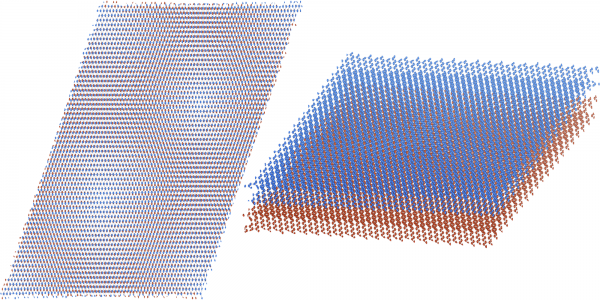Dialing flat bands in twisted double bilayer graphene
by Carey Sargent, NCCR MARVEL, EPFL
Twisted bilayer graphene (TBG), a material made of two atom-thin sheets of carbon with a small twist, has attracted considerable attention in recent years because of its exceptional properties—when tuned to the so-called magic angle of 1.1 degrees, it features correlated insulating states and superconductivity.
Twisted double bilayer graphene (TDBG) is a cousin of TBG made of four graphene layers in total. With advances in the manufacturing of more complex twisted graphene systems, and the demonstrated sensitivity of the correlated phases in TDBG to factors such as electric displacement and in-plane magnetic fields that modify the band structure, a key remaining question involves understanding the very nature of band flattening in TDBG and figuring out what happens to the band structure when the twist angle changes.
In the paper Moiré Flat Bands in Twisted Double Bilayer Graphene, researchers examine this four-layer graphene configuration composed of two AB-stacked graphene bilayers that were rotated with respect to each other by a small angle. They then performed DFT calculations on this TDBG model with varying twist angles and including 4376 atoms per supercell.

Figure 1: Crystal structure of twisted double bilayer graphene.
These ab initio band structure calculations revealed unexpected energy gaps at touching of two parabolic bands characteristic of the AB-stacked bilayer graphene counterparts. These band gaps are not however qualitatively reproduced by the conventional tight-binding (TB) model—an approach to calculating electronic band structure that uses an approximate set of wave functions based upon superposition of wave functions for isolated atoms located at each atomic site—widely used for studying large models of twisted multilayer graphene at relevant small twist angles.
The researchers concluded that the mechanism responsible for this gap opening is not accounted for by the standard TB model. The effect comes, they said, from the fact that each of the AB-stacked BLG counterparts in TDBG is placed in an asymmetric environment: one of the graphene layers faces a vacuum and another the adjacent graphene layer. This produces a slight potential difference between the two graphene layers which in turn opens a band gap in otherwise gapless AB-stacked BLG. The researchers dubbed this effect “intrinsic symmetric polarization” (ISP).

They then looked to incorporate this effect into the TB model. The ISP can be depicted as effective electric fields that have opposite orientation in the two BLG subsystems. The magnitude of this electric field corresponds to the difference of on-site energies between the inner and outer layers of 30 meV. Since the potential difference is primarily related to the distance between the inner graphene layers in TDBG, the researchers decided that using a single universal value for the electric field was a plausible assumption for all twist angles.
They found that introducing an electric field value of 9 mV/Å into the tight-binding model allowed for the reproduction of the DFT results for all investigated TDBG models, including those that included lattice relaxation effects down to very small twist angles. The calculations also identified a narrow region around the magic angle of 1.3 degrees that is characterized by a manifold of remarkably flat bands that are gapped out from other states even without external electric fields. This value is favorably larger than the 1.1 degrees magic angle of the parent TBG system.
Finally, to understand the fundamental origin of the magic angle in TDBG, they constructed a continuum model that points to a hidden mathematical link to the twisted bilayer graphene (TBG) model. This indicates in turn that the band flattening is a fundamental feature of TDBG rather than the result of external fields.
In closely related experimental work presented in the Nature Physics paper Correlated states in twisted double bilayer graphene, Yazyev, Wu contributed theoretical understanding to show that TDBG is an easily tunable platform for exploring quantum many-body states. While twisted bilayer graphene with a small twist angle originally attracted interest because of the associated correlated insulating states and unconventional superconductivity, it is difficult to control the twist angle θ accurately enough to observe these interesting correlation-induced phenomena. This puts strict constraints on device fabrication—getting easier access to the flat band through alternative approaches is essential.
Though correlated insulator and superconductivity have recently been observed in TBG with θ>1.2° by exerting an external high pressure, simply exerting a displacement field to modulate the bandwidth of the flat band in this material has little effect because of the strong interlayer hybridization. TDBG on the other hand is also likely to possess a flat band—indeed, the Nature Physics paper shows that it does—and so display correlated phenomena. It also shows parabolic band dispersion and so gap opening at the charge neutral point (CNP) could be induced under displacement fields.
In the paper, the researchers worked on this assumption to explore the use of vertical displacement fields to control the electronic phases in TDBG. Under external displacement fields, electrons can be drawn towards the positive gate, and repelled from the negative one, thus inducing an asymmetric distribution of carriers between top and bottom graphene layers and destroying the expected correlated states. In TDBG, stronger screening and thus stronger layer asymmetry under displacement fields are expected.
In a specific range of displacement fields, the researchers observed correlated insulating states corresponding to the half-filled conduction band. Under parallel magnetic fields, they found that the correlated gap for the half-filled band increases, suggesting spin-polarized ordering. The results show that twisted double bilayer graphene can be easily tuned.
References:
Moiré Flat Bands in Twisted Double Bilayer Graphene Fatemeh Haddadi, QuanSheng Wu, Alex J. Kruchkov, and Oleg V. Yazyev Nano Letters Article ASAP
DOI: 10.1021/acs.nanolett.9b05117
Shen, C., Chu, Y., Wu, Q. et al. Correlated states in twisted double bilayer graphene. Nat. Phys. (2020). https://doi.org/10.1038/s41567-020-0825-9
https://doi.org/10.1038/s41567-020-0825-9
Low-volume newsletters, targeted to the scientific and industrial communities.
Subscribe to our newsletter